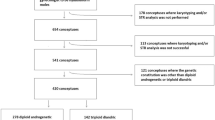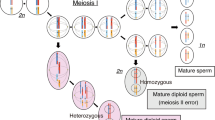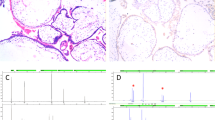Abstract
Complete or ‘true’ hydatidiform mole, an abnormality of human gestation, is characterized by hydropic degeneration of all placental villi, marked hypertrophy of the trophoblast, absence of a fetus and a propensity to become malignant. The chromosome constitution of complete moles is usually 46,XX1,2, and Kajii et al. reported that the entire genome in seven out of seven cases was paternal in origin, with all centromere markers homozygous for paternal heteromorphisms3. These observations, since confirmed4,5, can be explained by the fertilization of an ‘empty’ egg—no effective genome—by either a haploid sperm that then duplicates without cytokinesis, to restore the diploid number, or by a diploid sperm resulting from failure of the second meiotic division. We report here a study of a series of complete moles that shows the first alternative to be correct in the majority of cases.
This is a preview of subscription content, access via your institution
Access options
Subscribe to this journal
Receive 51 print issues and online access
$199.00 per year
only $3.90 per issue
Buy this article
- Purchase on Springer Link
- Instant access to full article PDF
Prices may be subject to local taxes which are calculated during checkout
Similar content being viewed by others
References
Vassilakos, P., Riotton, G. & Kajii, T. Am. J. Obstet. Gynec. 127, 167–170 (1977).
Szulman, A. E. & Surti, U. Am. J. Obstet. Gynec. 132, 20–27 (1978).
Kajii, T. & Ohama, K. Nature 268, 633–634 (1977).
Jacobs, P. A., Hassold, T. J., Matsuyama, A. M. & Newlands, I. M. Lancet ii, 49 (1978).
Wake, N., Takagi, N. & Sasaki, M. J. natn. Cancer Inst. 51–57 (1978).
Cavalli-Sforza, L. L. & Bodmer, W. F. The Genetics of Human Populations (Freeman, San Francisco, 1971).
Rao, D. C., Keats, B. J. B., Lalouel, J. M., Morton, N. E. & Yee, S. Am. J. Hum. Genet. 31, 680–696 (1979).
Dutrillaux, B., Laurent, C., Couturier, J. & Lejeune, J. C.r.hebd. Séanc. Acad. Sci. Paris 216, 3179–3181. (1973).
Yamashita, K., Wake, N., Araki, T., Ichinoe, K. & Makoto, K. Am. J. Obstet. Gynec. 135, 597–600 (1979).
Lawler, S. D. et al. Lancet ii, 580 (1979).
Surti, U., Szulman, A. E. & O'Brien, S. Hum. Genet. 51, 153–156 (1979).
Matsuura, J. S., Mayer, M. & Jacobs, P. A. Hum. Genet. 52, 203–210 (1979).
Sumner, A. T. Expl Cell Res. 75, 304–306 (1972).
Sonneborn, H. H. Humangenetik 17, 49–55 (1972).
Author information
Authors and Affiliations
Rights and permissions
About this article
Cite this article
Jacobs, P., Wilson, C., Sprenkle, J. et al. Mechanism of origin of complete hydatidiform moles. Nature 286, 714–716 (1980). https://doi.org/10.1038/286714a0
Received:
Accepted:
Issue Date:
DOI: https://doi.org/10.1038/286714a0
This article is cited by
-
Genotyping diagnosis of gestational trophoblastic disease: frontiers in precision medicine
Modern Pathology (2021)
-
Male factor infertility and placental pathology in singleton live births conceived with in vitro fertilization
Journal of Assisted Reproduction and Genetics (2021)
-
Role of genomic imprinting in mammalian development
Journal of Biosciences (2020)
-
Characteristics of hydatidiform moles: analysis of a prospective series with p57 immunohistochemistry and molecular genotyping
Modern Pathology (2014)
-
Mosaics and moles
European Journal of Human Genetics (2011)
Comments
By submitting a comment you agree to abide by our Terms and Community Guidelines. If you find something abusive or that does not comply with our terms or guidelines please flag it as inappropriate.



